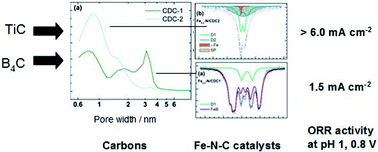Synthesis of highly-active Fe–N–C catalysts for PEMFC with carbide-derived carbons†
Abstract
Proton exchange membrane fuel cells (PEMFC) offer a viable alternative to internal combustion engines, but highly performing stacks still require large amounts of platinum-based catalysts. Fe–N–C catalysts have recently emerged as potential substitutes. Carbide-derived carbon (CDC) can be designed to have various pore size distributions (PSD), in the microporous and/or mesoporous domains, which can be used for defining the number and/or accessibility of active sites in Fe–N–C catalysts based on the CDC. In this work, we compare two sets of Fe–N–C catalysts derived from two different CDCs, one with most frequent pore size of 8.5 Å, (CDC-2) and another one with most frequent pore sizes at 7.8 and 30 Å (CDC-1). The CDC-based Fe–N–C catalysts show excellent half-wave potential for oxygen reduction reaction (ORR) of 0.81 V vs. RHE in 0.5 M H2SO4. This work presents the first study of CDC-based catalysts in a PEMFC, where the performance of the CDC-2 based catalyst rivaled that of the best Fe–N–C materials in the literature. The catalyst derived from CDC-2 showed ca. 5 times higher activity at 0.8 V vs. RHE than the one derived from CDC-1. We show that the residual presence of boron in CDC-1 is the main reason for the lower activity of CDC-1 derived catalysts, leading to the formation of iron boride instead of ORR-active FeNxCy moieties. Higher Fe contents were investigated for CDC-2, but lead to unmodified activity, which is explained from Mössbauer spectroscopy measurements by the increasing formation of ORR-inactive Fe species at high Fe content. In summary, we demonstrate the excellent potential for CDC materials to be used in catalyst design and also identify some key issues that may arise from the possible residual presence of secondary atoms from the starting carbide.



 Please wait while we load your content...
Please wait while we load your content...
